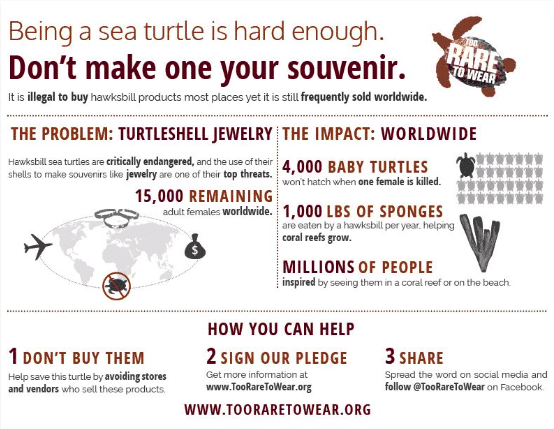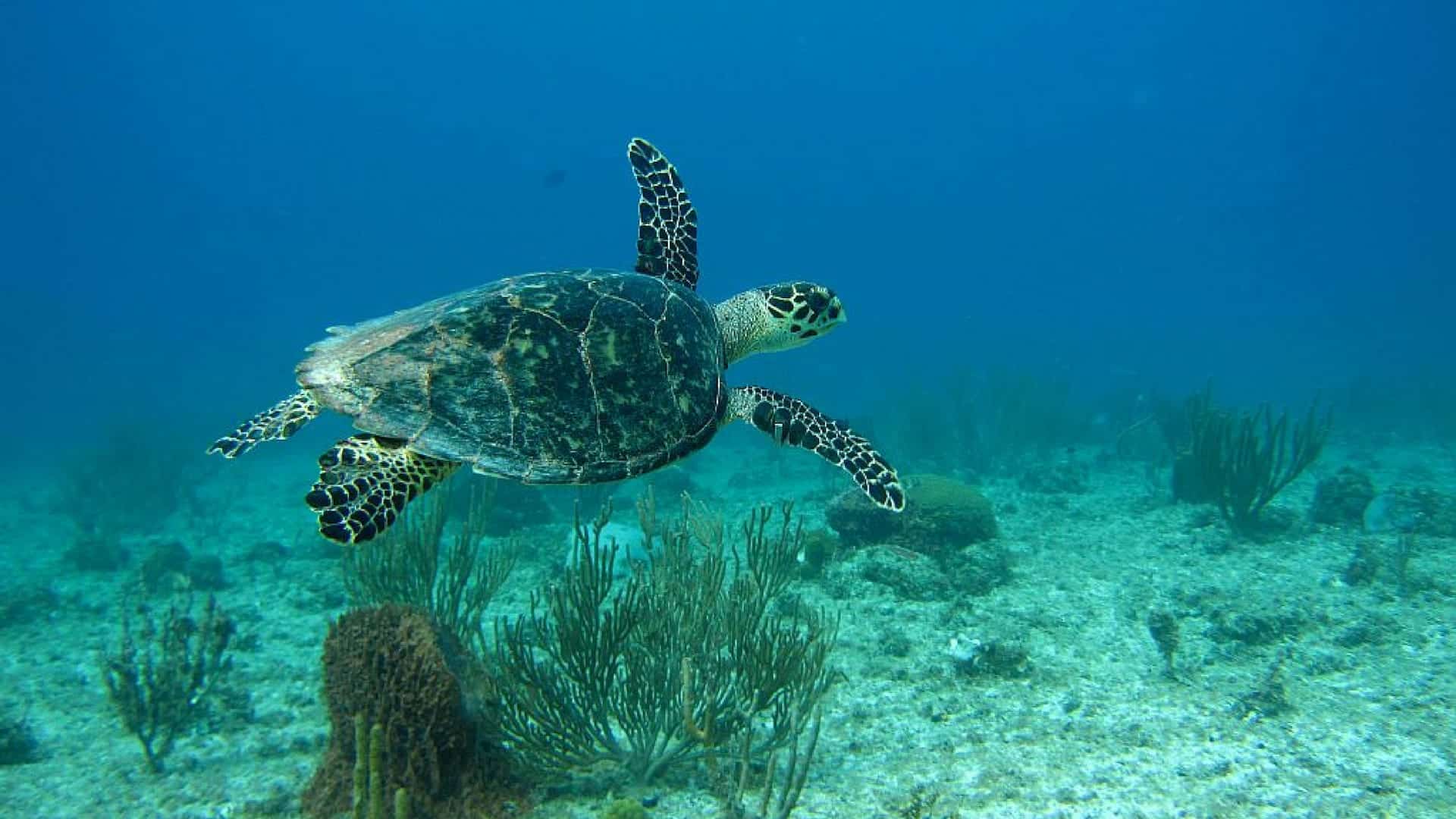
The heartbreakingly beautiful Hawksbill Turtle loves coral reefs and rocky areas, lagoons, mangroves (the Pacific coast of the America’s, primarily El Salvador and Nicaragua), oceanic islands (both coasts of Nicaragua, Mexico’s Yucatan peninsula, Brazil, Australia, Malaysia, and Indonesia ) and shallow coastal areas all around the tropical oceans of the world.
Turtles have been swimming in the oceans for the last 100 million years.
The Hawksbill has a narrow head and a raptor-like beak which enables it to reach into cracks and crevices to retrieve food. They feed almost exclusively on sponges and adults weigh between 100-200 pounds (45 – 90 kg) and reach 2-3 feet (roughly .5 to 1 meter) in length.
The turtles are important for coral reef health in coastal economies around the world. As they feed on the sponges that compete with corals they assist the reefs to maintain a balance and continue growing. The sponges are toxic to all other animals due to the spicules (glass-like spines) they contain, but the Hawksbill turtle is immune to this and so competition for the sponge delights is very small. The Hawkbill’s contribution to the ecosystem, the health of coral reefs and wider marine life is tremendous.
Why is Coral so Important?
A coral reef is the most diverse ecosystem on the planet. Coral reefs protect coastlines from the damaging effects of waves and tropical storms. They are also a shelter and a habitat for many marine organisms as well as providing essential nutrients for marine food chains. They assist in carbon and nitrogen-fixing as well as nutrient recycling.
As a direct consequence, the fishing industry depends on coral reefs due to all the fish spawning there. The Great Barrier Reef generates over 1.5 billion dollars for the Australian economy per year.
Coral reefs also provide us with a living history of a clear, scientifically-testable record of climatic events (including records of recent major storms and human impacts) over the past million years or so.
When our coral reefs aren’t healthy our ecosystems break down. This leaves us without natural recourses, with dirty water and air and excess pollutants. It also results in a lack of species diversity.

Coral, like humans, have a very sensitive temperature tolerance. A rise of as little as 35º F (2º C) will kill the coral. Effectively instigating a fever-like event which causes to coral to starve and only the skeletons will remain. This is known as coral bleaching.

Fashionable tortoiseshell, traditionally used for jewelry and other trinkets originally come from the Hawksbill. Apart from being coveted for their shells, the turtles are also threatened by consumption of their eggs, unsustainable fishing practices and the unsustainable development along the coast. These turtles are now critically endangered with the Eastern Pacific population now at fewer than 1,000 estimated between Mexico and Ecuador.
The IUCN estimates only 15,000 adult female turtles remain alive in the five Hawksbill Turtle communities worldwide. This is difficult to confirm. Some estimates go as low as a total of 8,000 turtles alive on earth, with only 1,000 females nesting each year.
About Too Rare To Wear
A coalition of over 50 conservation organizations, tourism businesses and organizations aim to end the demand for Hawksbill sea turtle products for sale in the tourist destinations around the world.
The Too Rare To Wear campaign educates travelers and supports outreach efforts with conservation partners around Latin America.
PARTICIPATE
Sign the Pledge to Avoid Turtleshell
When traveling in Latin America and the Caribbean, I pledge to shop carefully at souvenir shops and look for and avoid any products made of turtle shell, including bracelets, earrings, rings, guitar picks, combs, and fans.
When I find a turtle shell for sale, I will let the vendors know that I only purchase from stores that are turtle-friendly.
Instead, I will look for and purchase locally-made and eco-friendly products.
And I will encourage my friends and family to avoid turtleshell products and share this campaign with them.
Turtle Shell => What you NEED to know

Your guide to avoiding Turtle shell
More Incredible Facts About the Hawksbill Sea Turtle
- The Hawksbill turtle is the most endangered of all turtles on earth.
- Turtles leave the sea to lay their eggs on the beach every two to three years. They will choose a spot, dig a hole, lay between 60 and 200 eggs, cover them up and return to the sea leaving their eggs behind. The eggs will remain buried for around 60 days until they hatch.
- The largest Hawksbill colony in the world nests on Milman Island in Queensland, Australia.
- The Hawksbill Turtle is omnivorous. Their narrow pointed beak is a specialized feeding tool, much like that of a bird of prey. Its shape and length allow the turtle to reach into small cracks in the coral reef to extract sponges and other invertebrates.
- Apart from sponges they will also eat sea anemones, mollusks, jellyfish and are known to be opportunistic predators.
- The beautiful Hawksbill shell is tough and effectively protects them from predators. However, they still fall prey to sharks, crocodiles, octopus and the biggest predator of all, humans.
- Their beautiful gold and brown patterned shells, also known as “tortoiseshell”, are hunted and sold illegally on the black market. They are used to create ornamental products and valuable jewelry.
- In Japan, the Hawksbill Turtle shells, known as “bekko”, has been part of the traditional culture for 300 years and even now is used in traditional wedding dresses.
- The trade of this turtle shell is illegal in an effort to conserve the population. Despite this, the Hawksbill Turtle shell is still found in souvenirs and jewelry. In fact, it’s the most frequently confiscated illegal item by customs officials.






